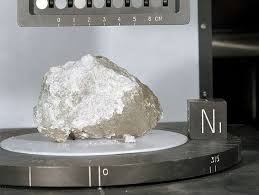Moon’s missing metals’ mystery

Islamabad: For decades, scientists have tried to figure out why the Moon has a thousand times less precious metals than Earth. Turns out the metals may not have been delivered after all.
Colliding asteroids delivered metals such as gold and iridium to both Earth and the Moon early in the solar system’s history, with Earth collecting more than its smaller satellite.
But samples of Moon rocks collected by Apollo missions revealed that the Moon had significantly less material than could be accounted for by its size. New research now suggests that the dearth may be caused in part by the Moon’s inability to hold on to some of these metals, with the late crystallization of the lunar mantle also playing a role.
The early solar system was a violent place, with material left over from planet formation crashing into newborn worlds. One collision carved the Moon out of Earth, leaving both worlds briefly molten as their layers settled out. Precious metals, which have an affinity for iron, sank to the cores of newborn worlds, removing them from the crust and mantle. Any of these highly siderophile elements (HSEs) found in the crust today were delivered by collisions with smaller debris.
Because Earth presents a larger target than the Moon, scientists anticipated that the Moon should have roughly 20 times less HSEs at its surface. Instead, Apollo samples revealed that the satellite contains roughly 1,000 times less precious metals than Earth, suggesting that perhaps it was hit by significantly fewer objects. The discrepancy has had scientists scratching their head for the past few decades.
“We identify that a key factor for the interpretation of the HSE record is the impactor retention rate—the fraction of mass retained by the target,” Meng-Hua Zhu, a scientist at China’s Macau University of Science and Technology, said by email.
Zhu’s team modeled how much material the Moon collected from impacts on the basis of their size and the angle at which they hit. The researchers assumed that the more massive Earth retained the bulk of the precious metals delivered to it, an assumption that Simone Marchi calls “reasonable.” Marchi is a researcher at the Southwest Research Institute in Colorado who models the formation and bombardment of terrestrial planets and the Moon.
The new research reveals that the Moon holds on to only about 20% of the material that it collides with, 3 times less than previously assumed.
“This strikingly low value changes previous considerations on the Moon’s late accretionary history and suggests that significantly more material must have hit the Moon for a given HSE budget than previously envisioned,” Zhu said.
The amount of debris lost from lunar collisions filled in only part of the discrepancy, bringing the Earth-Moon difference down to only about 100. So Zhu’s team turned to the lunar magma ocean.
After the collision that birthed the Moon, the surface of both worlds remained molten. Previous studies suggested that Earth’s magma surface took somewhere between 5 million and 10 million years to solidify into a rocky crust. Apollo samples suggest that the smaller Moon took longer to solidify, between 150 million and 200 million years, although not all scientists agree with this analysis. “It’s a problem that’s been debated for years,” says James Day, a geologist at the University of California, San Diego.
Assuming a long-lived molten mantle, material that slammed into Earth roughly 15 million years after the Moon formed would have polluted the terrestrial crust. But material colliding with the Moon at the same time would have been absorbed by its mantle and worked its way down to the core. The difference gives Earth a head start in collecting HSEs on its surface and could explain the rest of the discrepancy.
Although Day appreciates the implications of the new collisional model, he’s less certain about the molten magma explanation. “Purely from a geochemical point of view, that is still a problem,” he says. “I don’t think it’s a fatal flaw in their model by any stretch of the imagination, but it’s something that needs to be considered.”
Marchi also has concerns about the Moon’s magma ocean. According to the new research, the Moon should have 3–8 times more basins than those that visibly scar its surface today. Zhu argues that the magma ocean would quickly obliterate both crater rims and gravitational signatures, but Marchi isn’t certain. Although objects slamming into the Moon immediately after its formation should have been absorbed, it’s possible that cooling over the intervening tens of millions of years would have prevented a complete erasure of crater signatures.
“It may be possible, but I think it requires further investigation,” Marchi says





